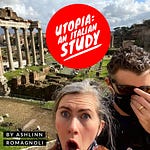Ciao belle!
This is the start of a series on La Dolce Vita. You can also follow @utopiaitalia on instagram for more pictures and video content!
If you’re jonesing for more Utopia: An Italian Study or just want to support my work (thanks!), consider signing up for just $5.99 per month for full access to the series, including the podcast Utopia Unfiltered, wherein I have a few drinks and freestyle chit chat about an aspect of Italian life suggested by a subscriber.
If you can’t contribute but are enjoying what you hear or read, you can help me out by sharing with your friends, family, frenemies, and enemies!
Ciao for now,
x ash
I recently told a friend my ‘brilliant’ and highly controversial idea: I want to put a cartoon room in the Uffizi.
I know, I know.
Hear me out. After Adam and I had spent three hours at the museum, we were only through half of it, with some of the most famous and valuable artworks still ahead of us. We were so overwhelmed that we had to stop for an hour at the museum caffe, and even after that my head was still quite literally spinning. At this point I came up with my idea— I wanted to watch half an hour of saturday morning cartoons, something mindless and stupid, to reset my brain and prepare me for the wonders that still remained in the museum.
Kind of like sniffing coffee beans between perfume samples.
My friend laughed, let me know that art fatigue is a real, documented thing, and told me her own approach: she picks only 4-5 major artworks per museum she visits in Italy, spending up to half an hour absorbing each one. This of course means she misses seeing many famous works, but she actually remembers each piece in detail: what it looked like, how it made her feel. Certainly it’s possible that she didn’t choose the artworks that might have been the most impactful for her, and it’s a bold woman who would forgo several Boticelli for a Michelangelo, but this conversation really got me thinking about that quintessential Italian dream: la dolce vita.
La dolce vita is, fundamentally, an attitude: a savoring of life, pleasures both simple and elaborate. But la dolce vita, unfortunately, does not often live in carefully planned itineraries, especially not crowded ones. It demands time to unfold. It does not hold with the very capitalistic concept of quantity over quality. And in a country that has such an enormous quantity of quality to choose from, this is a frustrating reality.
You see, not long before this conversation I had received an email from a dear friend about an impending trip to Italy she and her partner are planning. I nearly choked on my coffee when I read her proposed itinerary: ten days, four cities, no fewer than four major cultural activities per day spread in a not small quadrilateral between Rome, Turin, Venice, and Florence.
On one hand: I get it.
Although France and Spain both apparently beat Italy in number of tourists per year, I will die on the hill of Italy for sheer assemblage of incredible places to visit. Paris might be Captain Marvel, who can more or less kick anyone in the known universe’s ass by herself, but Italy has like… all of the rest of the Avengers. (And if you weren’t aware that I am a huge nerd before, now you know.)
My point is that you can go to France, only see Paris, and still feel pretty good about yourself. Maybe in the summer you dip down to Nice. And yes, Marseille and Toulouse are lovely, as are the countless incredibly charming French villages that dot the countryside. Apparently, Lille is also a top tourist destination. Who knew?
But Italy? After Rome, Italy also boasts of Naples, Venice, Florence, Milan. Moving down the size/fame scale, we have Pisa, Bologna, Cinqueterre, Sorrento, Verona, Assisi. And those are just places that I’d bet money someone who has never been to Italy would be able to name. This list doesn’t even include incredible hidden gems (*cough*Turin*cough*).
Turin is actually a great example of what I’m getting at.
If I told you you could go visit a Roman-settled city with the most number of ancient Egyptian artifacts outside of Cairo, with stunning architecture of gorgeous 16-18th century palazzos & gardens and some of the best art deco buildings to be found anywhere, that’s the center of its country’s beloved cinema history and contemporary arts scene, that houses one of the most famous religious relics in the entire world, and that invented breadsticks and nutella--- nutella, people-- who on earth would not leap at the chance to visit such a marvelous place?
…until you find out that it’s a city in Italy, and if you’ve never been to Italy before, well… Turin doesn’t even rank as one of the options you’d consider, not when you’ve got Florence and Rome and Venice and and and on the list. So maybe on the next trip. Or the third. If you can return at all.
So, understanding the scale of what’s at stake to see and do when you come to Italy, it makes sense to cram as many cities as feasible into your trip and pack as many sights and experiences into any given day as possible. I know many people do this, and I really cannot blame them. As a person who has the great privilege of living here, I should probably just shut the fuck up and let people do whatever they want with their vacation.
And yet… as a person who does live here, I have also grown to understand a bit of the nuance of la dolce vita, which is arguably one of the best contributions Italy has made to the world (which is saying something) and one of the most cited reasons for tourists to visit at all.
La dolce vita is, to give another example from my own life, taking a risk by spending a valuable meal time in a tiny restaurant near your airbnb that has, god forbid, fake old frescoes painted on the wall, only to have one of the most delicious meals of your life served by a man with the kindest smile you’ve ever seen. We would never in a million years have chosen this restaurant based on its reviews, but by opening ourselves up to possibilities, by not planning that meal and taking a little risk, we gave ourselves an unexpected and wonderful gift that I’ll always remember and cherish.
In short, a major component of la dolce vita is experiencing pleasures that cannot be planned or forced or that require so much of a time commitment that they preclude many other things. La dolce vita is like a house cat at a dinner party in this way: it may saunter in and around the guests, occasionally gracing someone with a head nuzzle or-- dare I say it-- some time purring on a lap, but what it won’t do is come when it’s called. And usually, it spends the most time with those who don’t try to force an interaction.
This is a problem, because the unplanned comes without guarantee, which makes it an inherently risky dream in which to indulge. Tourists are paying hard earned money for their trips (and if they’re American, spending precious, limited vacation days), and need a certain return on their investment. Because although the restaurant experience I described above has the potential to be one of the most delicious and fondly remembered meals of your life… it also might be unpalatable or even worse: unremarkable. Who wants to risk having an unremarkable dinner on a trip with a limited number of meal slots available? Better to stick with an itinerary and a place that TripAdvisor can all but guarantee will be at least fine.
After all, even if you’re suffering from art fatigue and unable to recall the difference between the myriad well-rated restaurants you meticulously chose, a well planned trip will, at the very least, leave you having seen all of the things that you’re “supposed” to see when you come to Italy. And those things will almost certainly be worth it. I don’t think anyone has seen the Colosseum at night and failed to swoon, even after a long day of museums and walking (hmmm, maybe that explains the swooning), and for the most part I don’t think any restaurant with decent ratings in Italy would give you a bad experience.
Yet I do think you’ll be missing out on something essential about the Italian experience if you do this. Approaching a trip the la dolce vita way— less planning, more organic and holistic experiencing— is a high risk, high reward proposition that I recognize not everyone has the luxury, faith, or guts in which to indulge. For many, being secure in having seen as many of the ‘must sees’ as possible is more important than potential FOMO if you choose your sites more selectively or gamble on an unknown trattoria.
Packed itineraries are an attempt to safeguard against this fear of disappointment as well as make some sort of guarantee of a positive experience. They’re a hope, in a way, that siphoning tiny glimpses of la dolce vita across several rushed meal and cultural experiences will add up to feeling like you’ve truly experienced it.
If Rome isn’t doing it for you in a day, never fear: you’re to be whisked away to Florence the very next day, and Venice after that! Never mind that many places (I’m looking at you, Naples) need an adjustment period and time to settle into, to get even the slightest glimpse beyond the surface level. But in years to come, you can happily proclaim that you went everywhere and saw everything, even if it’s hard to pick out anything in particular. In a sense, you end up so overstimulated that it’s easy to mistake this for having an authentically good time. Kind of like getting too drunk to remember the party but presuming you must have had a blast given the level of hangover. Not saying a few drinks can’t be a fun time, but I think you get the point.
Because, to quote the recently departed Stephen Sondheim, “If life were made of moments, then you’d never know you had one.” There are infinite moments to be had in Italy, and without being careful and selective about what you choose to do (even at the expense of other precious moments), without slowing down to experience them, it’s hard to know if you’ll be able to actually experience la dolce vita– though you’ll certainly be able to recount many memorable and lovely things about your trip.
La dolce vita is the soul of Italy, but pursuing it may mean missing certain supposedly ‘unmissable’ parts of the country. This is certainly a steep price, and not for everyone— but worth consideration, I think. But as with everything in Italy, this is both true and there’s another side to this story… there is, of course, a secret trick to it all. But to hear it, you’ll have to tune in next time for part two of the La Dolce Vita series.









The Risky Pursuit of La Dolce Vita